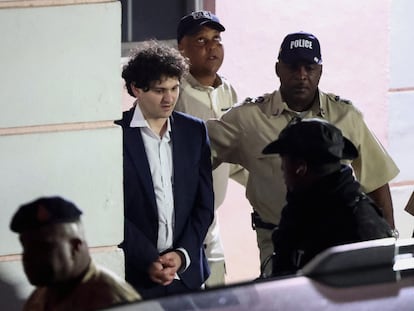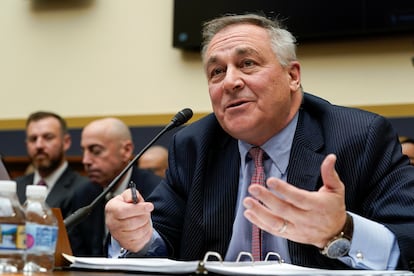‘Monopoly Money:’ How young crypto king Sam Bankman-Fried managed to fool everyone
Investors, lenders, customers and even oversight bodies failed to detect the failures behind FTX, the digital currency trading platform that was run with an accounting program for SMEs


Sam Bankman-Fried fooled everyone. He lied to the investors who got into FTX’s capital, to the lenders who entrusted him with money, and to the customers who traded through his cryptocurrency platform. And he did so amid the passivity of authorities and oversight bodies, which have only taken action in the aftermath of the scandal. The young crypto king did not even need to do it in a sophisticated way: he basically looted clients’ money for his own benefit. The company’s main asset ended up being the cryptocurrency that he himself issued and was ultimately “not very different from Monopoly money,” said New York Congressman Ritchie Torres in the House of Representatives on Tuesday.
The prosecution’s account, as well as the charges filed by the watchdog agencies Securities and Exchange Commission (SEC) and Commodity Futures Trading Commission (CFTC), along with descriptions by the company liquidator, John Ray III, have exposed what the US Attorney for the Southern District of New York, Damian Williams, defined on Tuesday as “one of the biggest financial frauds in American history.” The scale of the fraud places Bankman-Fried in the gallery of rogues along with names like Bernie Madoff, the creator of the notorious Ponzi scheme that went bust with the 2008 financial crisis. The hole is estimated at around $10 billion, taking into account the $1.8 billion defrauded from investors and the more than estimated $8 billion that he embezzled from clients of his crypto exchange.
The company lacked proper risk management procedures and was run in a sloppy way. Million-dollar transfers were ordered through chats and the company was managed with an accounting program meant for SMEs, as revealed on Tuesday by its liquidator and new chief executive, John Ray III, who was pessimistic regarding the possibilities that clients (it is estimated that there may be a million affected people) will recover their money. Ray said he does not know where the firm’s remaining assets are, and that the fact there is no paper trail makes the recovery task very complicated. Despite the fact that Ray has handled high-profile cases in the past, such as the Enron bankruptcy in 2001, the liquidator claims to have never seen anything like FTX in his entire career.
FTX was a hoax from the start. “Bankman-Fried was orchestrating a massive, yearslong fraud, diverting billions of dollars of the trading platform’s customer funds for his own personal benefit and to help grow his crypto empire,” according to the SEC’s complaint.
Bankman-Fried portrayed himself as a respectable leader in the crypto community who stressed the importance of regulation and accountability and ran an innovative yet responsible company. He presented himself as an honest visionary, supportive and concerned about the problems of humanity. He boasted of good relations with regulators. As part of his public relations campaign, he signed on celebrities such as American football quarterback Tom Brady, supermodel Gisele Bundchen and basketball player Stephen Curry; he sponsored the Miami Heat and announced FTX at the Super Bowl as “the safest and easiest way to buy and sell cryptocurrencies.”
As a result, he attracted billions of dollars from clients who thought that their money was safe at FTX. “But from the start, Bankman-Fried improperly diverted customer assets to his privately-held crypto hedge fund, Alameda Research LLC, and then used those customer funds to make undisclosed venture investments, lavish real estate purchases, and large political donations,” said the SEC in its complaint.
One big lie
The SEC explains that the FTX founder, now 30 years old, told existing and prospective investors that his marketplace had sophisticated automated risk measures in place to protect customer assets, that those assets were safe and secure, that his firm was transparent, and that Alameda, the seed of the group, was just another client of the platform without any special privileges. It was all “false and misleading.” Customer money was being transferred to accounts that were actually controlled by Alameda. There was no transparency and no proper controls. On top of that, Alameda got preferential treatment, was not subject to risk mitigation measures, and had a virtually unlimited line of credit that was funded by the platform’s customers.
With his deceptive statements about the company’s innovative and sophisticated risk control systems, Bankman-Fried raised at least $1.8 billion in different rounds of financing in which equity investors were incorporated as shareholders. FTX’s valuation was going up (it reached $32 billion) and, on paper, Bankman-Fried had become, at the age of 29, one of the wealthiest individuals in the world. In those issuances of shares, he attracted at least 90 US investors who contributed over $1 billion. The founder of FTX misled them, but it is surprising that none of them did their homework to know where they were putting their money. When cryptocurrencies were on the rise, Alameda used the theoretical latent capital gains to buy real estate, make risky investments and make multimillion-dollar donations to political parties. When in May 2022 the value of crypto assets plummeted in the markets, the house of cards began to collapse.
Billions in loans
Alameda’s lenders began demanding loan repayment or new collateral. Although Alameda had already taken billions of dollars of assets from FTX customers, it was unable to pay its debts due to losses on its own investments, so Bankman-Fried ordered FTX to divert billions more from customer assets to Alameda to maintain its good relationship with lenders and keep the money flowing, the SEC notes.

It was a headlong race to nowhere, but Bankman-Fried kept at what the liquidator, John Ray III, defined on Tuesday as “really just old-fashioned embezzlement.” Despite knowing that his situation was unsustainable and that Alameda owed FTX billions (that actually belonged to customers), he continued to appropriate funds during the summer for new investments, to provide loans to himself and the co-founders of FTX (Bankman-Fried took $1.34 billion; Nishad Singh took another $554 million and Gary Wang, $224.7 million) for luxury home purchases in the Bahamas or for political donations. He even presented himself as a savior of the industry, supporting other firms in trouble. “We take our duty seriously to protect the digital asset ecosystem and its customers,” he tweeted when he gave BlockFi a line of credit, presenting himself as a cryptocurrency hero despite the fact that his own empire already had feet of clay. BlockFi also ended up going bankrupt.
Bankman-Fried continued to mislead investors about his firm’s situation to try to plug the hole. But it didn’t work. The downward spiral was unleashed when the specialized media outlet CoinDesk revealed that FTX had a strong exposure to its own cryptocurrency, FTT. In fact, Alameda had been using FTT tokens as collateral for the more than $8 billion in cash that it had taken from customers through the line of credit. The futures market regulator accuses the firm of having manipulated the price of its cryptocurrency in the market.
Rival exchange Binance, which had been a shareholder in FTX, received payment for its stake in FTT on the premise that its price was a market value and that the platform did not hold its own cryptocurrency as an asset or control its price. Upon learning that this was not the case, Binance decided to sell. The cryptocurrency had no liquidity. In a vicious circle, the value of FTX depended on its assets in FTT and the value of that cryptocurrency depended on the value of FTX. Once the real dollars had left for Alameda, the tokens had become something like “Monopoly money.”
The customers claimed their money, the company was unable to deliver and withdrawals were halted, despite the fact that Bankman-Fried had previously tweeted that there was no problem and that there was enough money to pay back all customers, lying once again to avoid collapse. The value of FTT plummeted 80% in one day. FTX tried to get bailed out by Binance – which has now been caught up in the crisis of confidence and losing customers – but after a minimal review, it was ruled out. Bankman-Fried resigned and his successor, nominated by creditors, declared bankruptcy.
Political parties
The prosecution and supervisors began to investigate “against the clock,” according to Attorney Damian Williams. Charges were filed on Wednesday of last week, Bankman-Fried was indicted by a grand jury on Friday, and an arrest warrant was issued to the Bahamas, where he was taken into custody this past Monday. On Tuesday, a judge denied bail after considering him a flight risk. That same day he had been scheduled to testify virtually before the US House Financial Services Committee, which went ahead and held the session without his testimony, triggering some suspicions that the coincidence might be a way of keeping his mouth shut. Bankman-Fried has donated tens of millions of dollars to both the Democratic and Republican parties, and has done so illegally, according to the prosecution, using customers’ money. Parties are being asked to refund the donations.
Attorney Damian Williams on Tuesday listed the eight counts of conspiracy and fraud that Bankman-Fried is facing: conspiracy to commit wire fraud on customers, wire fraud on customers, conspiracy to commit wire fraud on lenders, wire fraud on lenders, conspiracy to commit commodities fraud, conspiracy to commit securities fraud, conspiracy to commit money laundering and conspiracy to defraud the United States and violate campaign finance laws. So far, there are no other defendants in the case.
Sign up for our weekly newsletter to get more English-language news coverage from EL PAÍS USA Edition
Tu suscripción se está usando en otro dispositivo
¿Quieres añadir otro usuario a tu suscripción?
Si continúas leyendo en este dispositivo, no se podrá leer en el otro.
FlechaTu suscripción se está usando en otro dispositivo y solo puedes acceder a EL PAÍS desde un dispositivo a la vez.
Si quieres compartir tu cuenta, cambia tu suscripción a la modalidad Premium, así podrás añadir otro usuario. Cada uno accederá con su propia cuenta de email, lo que os permitirá personalizar vuestra experiencia en EL PAÍS.
¿Tienes una suscripción de empresa? Accede aquí para contratar más cuentas.
En el caso de no saber quién está usando tu cuenta, te recomendamos cambiar tu contraseña aquí.
Si decides continuar compartiendo tu cuenta, este mensaje se mostrará en tu dispositivo y en el de la otra persona que está usando tu cuenta de forma indefinida, afectando a tu experiencia de lectura. Puedes consultar aquí los términos y condiciones de la suscripción digital.
More information
Archived In
Últimas noticias
Most viewed
- Sinaloa Cartel war is taking its toll on Los Chapitos
- Oona Chaplin: ‘I told James Cameron that I was living in a treehouse and starting a permaculture project with a friend’
- Reinhard Genzel, Nobel laureate in physics: ‘One-minute videos will never give you the truth’
- Why the price of coffee has skyrocketed: from Brazilian plantations to specialty coffee houses
- Silver prices are going crazy: This is what’s fueling the rally










































